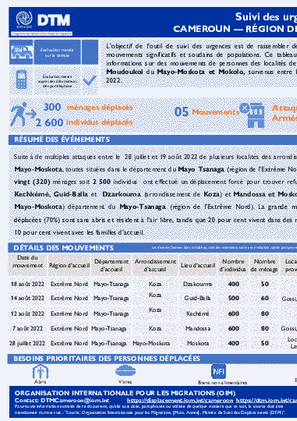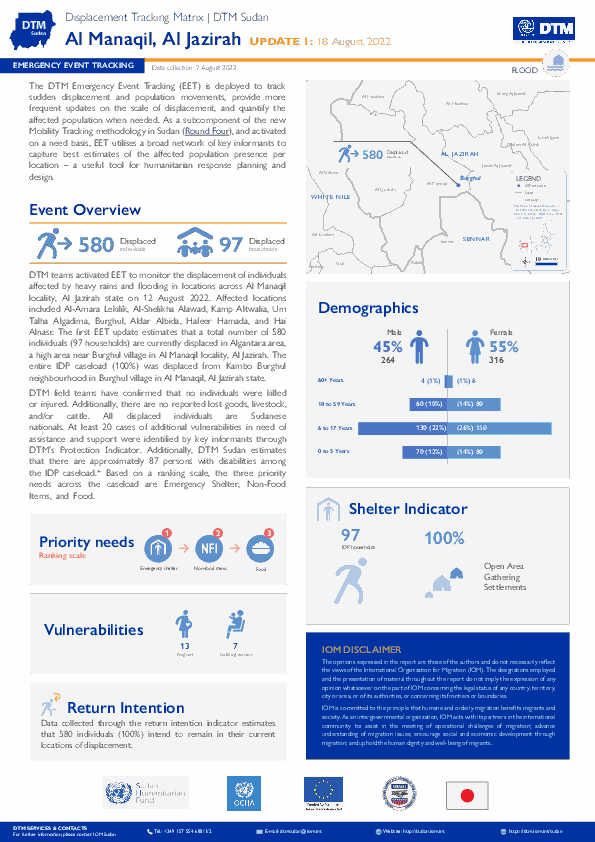-
Countries
-
Data and Analysis
-
Special Focus
-
Crisis Responses

Contact
DTM Cameroon, DTMCameroun@iom.int
Language
French
Location
Cameroon
Period Covered
Jul 28 2022
Aug 19 2022
Activity
- Mobility Tracking
- Event Tracking
L’objectif de l’outil de suivi des urgences est de rassembler des informations sur les mouvements significatifs et soudains de populations. Ce tableau de bord présente des informations sur des mouvements de personnes des localités de Moutsikar, Bigdé et Moudoukoi du Mayo-Moskota et Mokolo, survenus entre le 28 juillet et 19 août 2022.

Contact
DTM Guinée, oimguineedtm@iom.int
Language
French
Location
Guinea
Period Covered
Jul 01 2022
Jul 31 2022
Activity
- Flow Monitoring
Le suivi des flux, qui est mis en œuvre en étroite collaboration avec les autorités et des partenaires nationaux et locaux, est composé de deux outils: l’enregistrement des flux (Flow Monitoring Registry, FMR) et les enquêtes individuelles (Flow Monitoring Survey, FMS). Il récolte des données clés sur les flux migratoires, les profils des voyageurs et les parcours et intentions des migrants, afin de fournir une meilleure compréhension des flux migratoires dans la région.
Ce rapport présente les données obtenues à travers le FMR pendant le mois de juillet 2022 au niveau des FMP de Boundoufourdou (préfecture de Koundara) dans le nord du pays, de Kourémalé et Nafadji (préfecture de Siguiri) dans le nord-est de la Guinée.
Contact
DTMUkraine@iom.int
Location
Ukraine
Activity
- Mobility Tracking
- Baseline Assessment
Period Covered
Aug 08 2022 -Aug 19 2022
A baseline assessment is a sub-component of mobility tracking. It aims to collect data on IDP, migrant or returnee population presence in a defined administrative area of the country.
Population Groups
Survey Methodology
Unit of Analysis Or Observation
Type of Survey or Assessment
Keywords
Geographical Scope
Administrative boundaries with available data
The current dataset covers the following administrative boundaries
Contact
DTMUkraine@iom.int
Location
Ukraine
Activity
- Mobility Tracking
- Baseline Assessment
Period Covered
Aug 08 2022 -Aug 19 2022
A baseline assessment is a sub-component of mobility tracking. It aims to collect data on IDP, migrant or returnee population presence in a defined administrative area of the country.
This is a restricted dataset. To get access, kindly click on the 'Request Access' button.
Population Groups
IDPs
Survey Methodology
Unit of Analysis Or Observation
Admin Area 2
Type of Survey or Assessment
Key Informant
Keywords
Geographical Scope Partial Coverage
Administrative boundaries with available data
The current dataset covers the following administrative boundaries

Contact
DTM Mauritania, DTMMauritania@iom.int
Language
English
Location
Mauritania
Period Covered
Jul 01 2022
Jul 31 2022
Activity
- Other
Dans le cadre du projet « Initiative FFUE – Pour le renforcement de la gestion des frontières, la protection et la réintégration des migrants » financé par l’Union Européenne, l’OIM met en oeuvre le Système de Suivi des Populations Mobiles, un système de collecte et gestion de l'information de l'OIM qui permet d’obtenir de l’information actualisée sur les déplacements et la mobilité des populations. Il s’agit de collecter des données structurées afin d'obtenir des informations approfondies sur la taille, l'emplacement, la démographie et les besoins des populations mobiles et déplacées, la dynamique et les tendances de la mobilité, ainsi que les facteurs de la mobilité. Cette activité est mise en oeuvre en collaboration avec le Groupement National des Associations Pastorales (GNAP).
C’est dans ce cadre que des procédures opérationnelles standards (PON) actuelles s’inscrivent dans l’objectif d’établir un mécanisme d’alertes précoces et d’appui aux populations pastorales spécifiquement focalisés sur les mouvements soudains et inattendus (internes et transfrontaliers) qui pourraient engendrer une augmentation de conflits et défis.

Contact
DTM Mauritania, DTMMauritania@iom.int
Language
English
Location
Mauritania
Period Covered
Aug 01 2022
Jul 31 2022
Activity
- Survey
- Flow Monitoring Survey
- Flow Monitoring
La transhumance est une pratique de longue date en Mauritanie où elle a évolué au cours des dernières décennies avec la raréfaction des routes empruntées par les troupeaux notamment affectés par une raréfaction des ressources. Par conséquent, des conflits peuvent survenir entre les agriculteurs et les éleveurs transhumants. Dans le cadre du Suivi des Mouvements de Transhumance, l’OIM met en œuvre un système d’alerte qui a pour objectif de recenser les mouvements inattendus de bétail et les conflits ou catastrophes liés à l’utilisation des ressources naturelles et aux interactions entre agriculteurs et éleveurs, de comprendre les modes de résolution de conflits existants et d’informer les autorités compétentes, dans l’objectif de réduire et prévenir les tensions dans les régions d’intervention. Ce tableau de bord présente les informations fournies par le biais de 21 informateurs clés, présents dans huit régions (Assaba, Brakna, Gorgol, Guidimakha, Hodh El Chargui, Hodh El Gharbi, Tagant et Trarza) pendant le mois de Juillet 2022.

Contact
DTM Mali, DTMMali@iom.int
Language
French
Location
Mali
Period Covered
Jul 01 2022
Jul 31 2022
Activity
- Mobility Tracking
- Baseline Assessment
Au cours des cinq premiers mois de l’année 2022, dans un contexte marqué par l’insécurité et la fermeture des frontières terrestres et aériennes entre le Mali et les pays de la Communauté Economique des Etats de l’Afrique de l’Ouest (CEDEAO), des combats et attaques sporadiques se sont poursuivis dans plusieurs localités du pays occasionnant des déplacements internes de populations civiles dans le Nord et dans le Centre du pays. Le caractère violent des conflits a provoqué d’importants déplacements de populations à l’intérieur du territoire malien et dans les communes frontalières entre le Burkina Faso et le Niger, avec des méthodes de mouvements très complexes à suivre. Des déplacements de courte durée ont continué à être signalés dans différentes régions du pays.
Chaque semaine, de nouvelles personnes déplacées internes (PDI) continuent d’être enregistrées. Ces mouvements ont un impact considérable sur les personnes forcées de fuir leurs foyers et sur les communautés qui les accueillent.
Afin de répondre aux besoins des populations déplacées internes, rapatriées et retournées, la Commission Mouvement de Populations (CMP) recueille et analyse les informations sur les mouvements de populations à l’intérieur du Mali, afin de fournir un état complet des mouvements de populations et à la demande de ses partenaires. Les membres de la Commission sont : la Direction Générale de la Protection Civile (Ministère de la sécurité intérieur), UNHCR, OCHA, PAM, UNICEF, ACTED, NRC, DRC, HI, Solidarités International, CRS, OIM, et DNDS. Plusieurs autres entités participent régulièrement aux rencontres de la Commission.

Contact
DTM Sudan; dtmsudan@iom.int
Language
English
Location
Sudan
Snapshot Date
Aug 04 2022
Activity
- Mobility Tracking
- Event Tracking
The DTM Emergency Event Tracking (EET) is deployed to track sudden displacement and population movements, provide more frequent updates on the scale of displacement, and quantify the affected population when needed. As a subcomponent of the new Mobility Tracking methodology in Sudan (Round Four), and activated on a need basis, EET utilises a broad network of key informants to capture best estimates of the affected population presence per location – a useful tool for humanitarian response planning and design.

Contact
DTM Sudan; dtmsudan@iom.int
Language
English
Location
Sudan
Snapshot Date
Aug 07 2022
Activity
- Mobility Tracking
- Event Tracking
The DTM Emergency Event Tracking (EET) is deployed to track sudden displacement and population movements, provide more frequent updates on the scale of displacement, and quantify the affected population when needed. As a subcomponent of the new Mobility Tracking methodology in Sudan (Round Four), and activated on a need basis, EET utilises a broad network of key informants to capture best estimates of the affected population presence per location – a useful tool for humanitarian response planning and design.

Contact
iomisbdtmremapteam@iom.int
Language
English
Location
Pakistan
Period Covered
Apr 01 2022
Jun 30 2022
Activity
- Flow Monitoring
IOM Pakistan collects data on the outflows of undocumented Afghan migrants at the Torkham and Chaman border crossing points in an effort to better understand the migration movements of undocumented Afghan migrants returning to Afghanistan from Pakistan. This report is part of the European Union funded project ‘‘Displacement Tracking Matrix Regional Evidence for Migration Analysis and Policy (DTM REMAP)”. Key findings during this reporting period are:
- From April to June 2022, 17,928 undocumented Afghan migrants spontaneously returned to Afghanistan, including 2,139 through the Torkham border point and 15,789 through the Chaman border point.
- Apart from the total number of undocumented Afghan returnees, border authorities facilitated the return of 432 individuals due to the lack of legal documentation to remain in Pakistan. Therefore, information concerning these 432 individuals is not included in the report analysis.
- The average family size of returnees was 8 individuals and 12 per cent of all returnees recorded during the reporting period were categorized as vulnerable persons.
- All returnees were carrying household items, personal belongings and cash when surveyed. They also traveled with additional items, such as productive assets (94%), transportation vehicles (6%) and livestock (1%).
- The top 3 challenges returnees expected to face in Afghansitan were: arranging livelihood, settling into a new city and finding better income opportunities.
